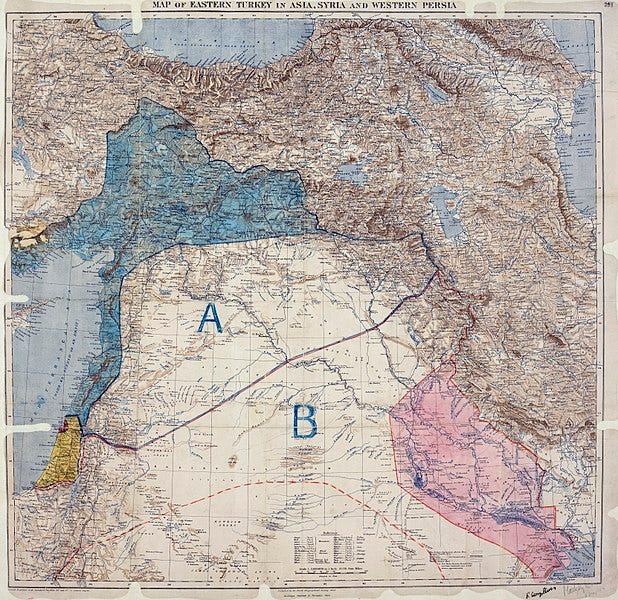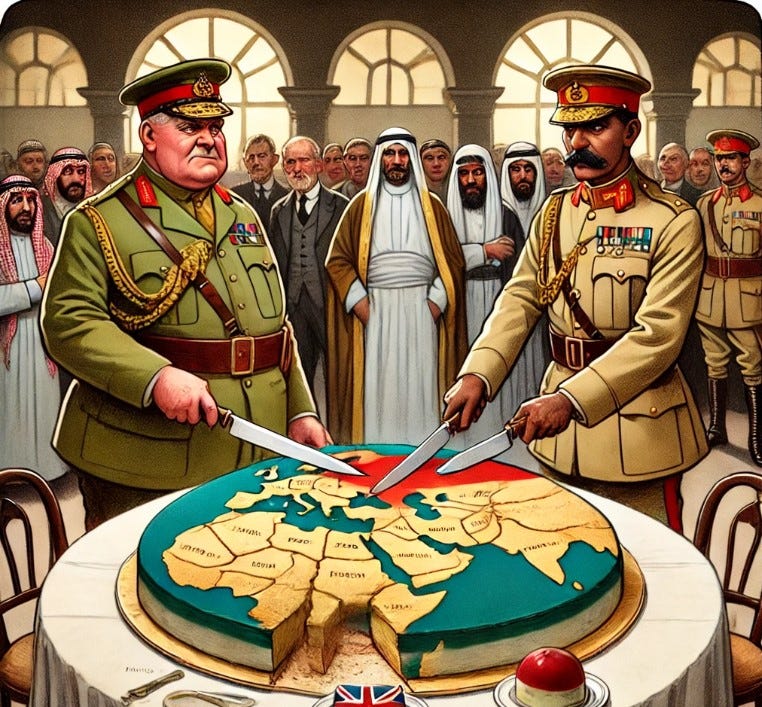A friend recently reminded me that I still had not mentioned the Sykes-Picot Agreement. While not directly tied to the Israel-Palestine conflict, this 1916 pact between Britain and France laid the groundwork for many of the Middle East's conflicts, including the one between Israel and Palestine. Signed secretly during World War I, it divided the crumbling Ottoman Empire into zones of European control. This agreement shaped the modern Middle East and established borders that continue to fuel division and instability.
Betrayal of Arab Aspirations
During World War I, Arab leaders supported Britain under the belief that they would gain independence in return for their efforts against the Ottoman Empire. However, the Sykes-Picot Agreement revealed Britain and France’s true intentions: to carve up the Middle East among themselves. This betrayal created lasting distrust between Arabs and Western powers—a sentiment that still echoes today.
The agreement also paved the way for the Balfour Declaration in 1917, where Britain promised to support the creation of a "national home for the Jewish people" in Palestine. Yet again, the Arab population was ignored, deepening the sense of injustice and fueling resentment. This pattern of disregarding the rights of indigenous populations became a defining feature of colonial rule in the region.

Patterns of Dehumanization
One of the most troubling aspects of the Sykes-Picot Agreement was the way it treated Arab lands and people as mere pieces in a European power game. The people of the region were not consulted about their future, and their lands were divided without regard for historical, cultural, or ethnic realities. This dehumanization continued with the Balfour Declaration, which promised land to Jewish people without acknowledging the Palestinians who had lived there for generations.
This same colonial mindset persists in the Israeli-Palestinian conflict today. Palestinians continue to be treated as obstacles rather than a people with a deep historical connection to their land. This mindset has justified displacement, occupation, and ongoing suffering. The borders drawn in 1916 did not just shape maps; they created divisions, sowed instability, and laid the foundation for decades of conflict.
Long-Term Consequences
The Sykes-Picot Agreement is a stark reminder of the dangers of colonial thinking—treating land and people as objects to be controlled rather than communities with rights and histories. It also highlights the long-lasting effects of disregarding the sovereignty of entire populations. Understanding this history helps explain the struggles Palestinians face today, not only in Palestine but across the broader Middle East.
The Sykes-Picot Agreement is a stark reminder of the dangers of colonial thinking—treating land and people as mere objects to be controlled. It also highlights the long-lasting effects of disregarding the rights of entire populations. Understanding this history helps us see the roots of the struggles Palestinians face today, but also conflicts across the broader Middle East.
As we witness current events unfold, it is essential to remember that the injustices Palestinians face are part of a long history of exploitation. Recognizing the legacy of colonial powers and the continuous dehumanization of Palestinians is an important step towards understanding and working for a just future.
All articles on Diaspora Dialogue are free to read for one year from publication. If you’ve enjoyed this piece and would like to support my work, you can do so by subscribing, or by buying me a coffee. Thank you for reading and being part of the dialogue!







